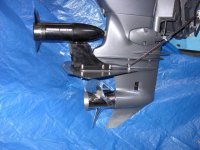I'm going to take the liberty of describing an inexpensive 120 volt shore power and generator set up that is easy to set up and costs a lot less than a $1000 shore power system from the factory, although the CD-25 now comes standard with it (I think).
Rather than cutting up the cabinetry and installing a lot of connection boxes, circuit breakers, outlets, reverse polarity indicators, and indicator lights, you can do it this way:
A GFI (ground field interruptor) type bus bar with a 6 foot pigtail is placed beside the helm on the left over space beside the motor controls. The tail is led aft underneath the galley and out the wiring port on the starboard side of the boat under the gunnel.
This GFI bus bar has the circuit breaker overload protection, the GFI protection, the monitor on/off light and switch, and the multiple outlets all in one $25 or so unit.
A standard grounded (3 wire polarized) extention cord is plugged into the tail of this bus bar from the dock for shore power usage.
(You will also probably have to have a twist and lock 30 amp male plug adapter to actually plug into the dock's shore power outlet, since they usually have this feature.)
In the simplest usage, applicances are simply plugged into the busbar and used in the cabin.
To adapt the set up to generator usage, the generator is placed somewhere convenient on the boat where the exhaust gases will not induce carbon monoxide poisioning in the crew, the generator linked to the bus bar pigtail with a short extension cord, then the generator is started, and now we have 120 volts for whatever needed.
I have a Honda 1000ia which I set on a large cooler in front of the engine well, tie down with a bungee cord, and run with the exhaust facing aft so that the exhaust will go down into the engine well and not into the cockpit.
To be able to charge one's batteries, you'll have to have an on board charger. This can be a hard wired marinized type, but I actually use a 40 amp automotive style charger, mounted up on the inside of the hull next to the helm wiring. I've hard wired it to the large cables coming up from the batteriess to the helm. The big deal about using a marinized unit on a boat is that they are sparkless, but there's no gas fumes up in the v-berth, unlesss the dog's been eating brocoli and beans again.
The charger is plugged into one of the bus bar outlets, and can be run from either 120 volt shore power or the generator.
I have this set up in my CD-22, and it works like a charm! Cost is about $625 for the Honda, $25 for the busbar, $15 for the extension cords, $5 for the adaptor (make it yourself!), and about $95 for the big charger.
Additionally, I have 4, not 2, group 27 batteries, two of which are under the forward dinette seat with their own 1-both-2- off switch. The charger will charge all four at the same time equally w/o problems as long as there all about the same condition. I added the last two batteries when I mounted an Engine Mounted Trolling Motor to the 2005 Yamahma last year as a substitute for a gas kicker. Much less trouble, but also much less thrust-trolling only up to 2 mph. Buat it's absolutely "silent running".
By using the two battery switches, you can use and charge any 1,2,3, or all of the batteries at will. Total amp hours available w/o using the generator or main motor to recharge is about 70% of the total 460 amp-hours at which the battiries are rated, or about 325 amp-hours.
I have evolved this set up over the past 7 years, dramatically increasing the battery storage capacity and adding the generator in the last two.
Some may offer the criticism that the shore power set up is not grounded. This can be simply done by attaching a ground wire from one of the plug outlets and connecting it to the negative side of the boat's 12-v system. Connecting it will stop any chance that ae electrical short on board will result in charging the nearby water and possibly paralyizing a nearby swimmer.
Do you swim around the docks? If not you may not need the ground.
When you connect the 120-v system to the 12-v via the ground, you also allow any stray currents around the dock to come on board through any of your boat's grounded metal fittings in the water, including the engine!
Les Lampman once wrote in a posting here that he didn't really like such a grounded system, as it could lead to more corrosion aboard than w/o a shore power system.
So for me, I'm leaving the system un-grounded, not swimming alongside when the shore power's connected, and saving my new engine and the rest of the boat's electrical system and electronics the corrosion that must by NEMA standards be incorporated into the more than twice as expensive system.
Joe.


